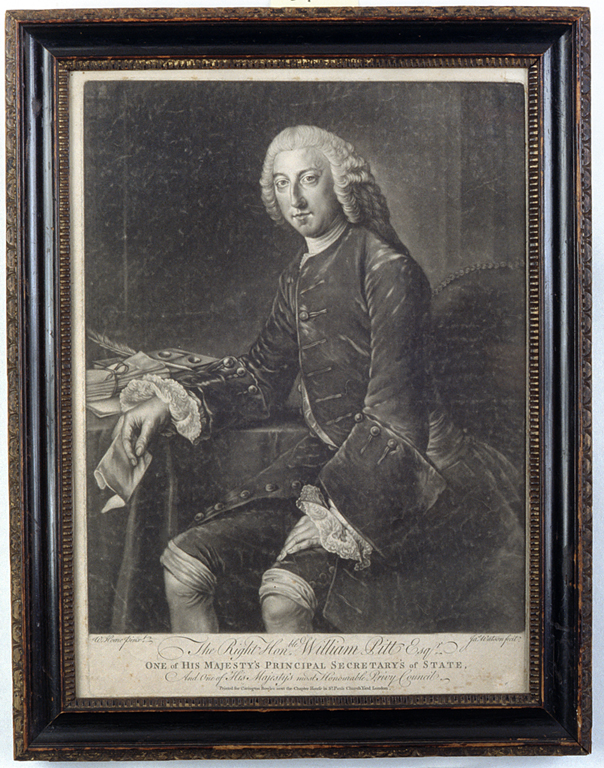| Maker(s): | Bowles, Carington (publisher); Watson, James (engraver) | | Culture: | English (1724-1793)
| | Title: | The Right Hon. William Pitt Esq. / ONE of HIS MAJESTY'S PRINCIPAL SECRETARY'S of STATE, / and One of His Majesty's most Honorable Privy Counsels
| | Date Made: | 1765-1778
| | Type: | Print
| | Materials: | paper, ink, wood, paint, gilding, glass
| | Place Made: | United Kingdom; England; London
| | Measurements: | framed: 13 in x 17 in; 33.02 cm x 43.18 cm
| | Accession Number: | HD 54.200
| | Credit Line: | Gift of Henry N. Flynt and Helen Geier Flynt
| | Museum Collection: | Historic Deerfield
|
|

|
Description:
Framed black and white mezzotint engraving titled "The Right Hon. William Pitt Esq. / ONE of HIS MAJESTY'S PRINCIPAL SECRETARY'S of STATE, / and One of His Majesty's most Honorable Privy Counsels." which was based on a circa 1754-1756 painting by William Hoare (1707-1792); engraved by James Watson (1739?-1790); and "Printed by Carington Bowles next the Chapter Road in St. Pauls Church Yard London." William Pitt (1708-1778), Earl of Chatham who was known as 'the Great Commoner', dominated the political scene influencing government from within and without as statesman and Prime Minister. He is remembered for his vocal criticism of harsh British policy levied against the American colonies and his skills as a wartime leader during the Seven Years' War when he organised the victories of 1759 over France which consolidated British sea power and brought territorial gains in India and Canada. Pitt resigned In 1761, but returned to office as Prime Minister in 1766, accepting an earldom, only to fall ill and retire. Although suffering from manic-depression, Pitt left his sick bed in 1778 to plead for a tolerant attitude to the British colonists in America. He was the father of William Pitt the Younger who became Prime Minister in 1783. William Hoare, RA, was apprenticed to Guiseppi Grisoni with whom Hoare travelled to Rome in 1728. On returning to England in 1738, Hoare settled in Bath where he became a governor of the hospital. During the 1740's and 1750's he painted a great number of influential politicians and social leaders, including William Pitt, such as this example of which there are several versions, and Walpole, and the composer, Handel. He was the first fashionable portraitist to settle in Bath, and he remained as the leading portrait painter there until the arrival of Thomas Gainsborough in 1759. Along with Gainsborough and Joshua Reynolds, Hoare was a founding member of the Royal Academy. James Watson was born in Ireland, and then settled in London where he learned engraving. He became one of the leading mezzotint engravers of the day, including 56 plates after the paintings of Joshua Reynolds. The majority of Watson's work was for Sayer, Boydell, Bowles and other printsellers, but he published some plates himself. Watson exhibited at the Society of Artists from 1762 to 1775. Representing the third generation of publishers, print and map sellers, Carington Bowles (1724-1793) worked with his father, John Bowles (1701-1779), in Cornhill until 1764 when he took over the firm vacated by his uncle, Thomas Bowles (1695-1767) in St. Paul's Churchyard, which he lead for thirty years until his death in 1793 when his son Henry continued under the partnership of Bowles & Carver. The engraver Richard Houston (1722-1775) had also done an earlier version of the Hoare painting, which had been used by John Bowles.
Tags:
portraits Subjects:
Portraits Link to share this object record:
https://museums.fivecolleges.edu/detail.php?t=objects&type=ext&id_number=HD+54.200 |